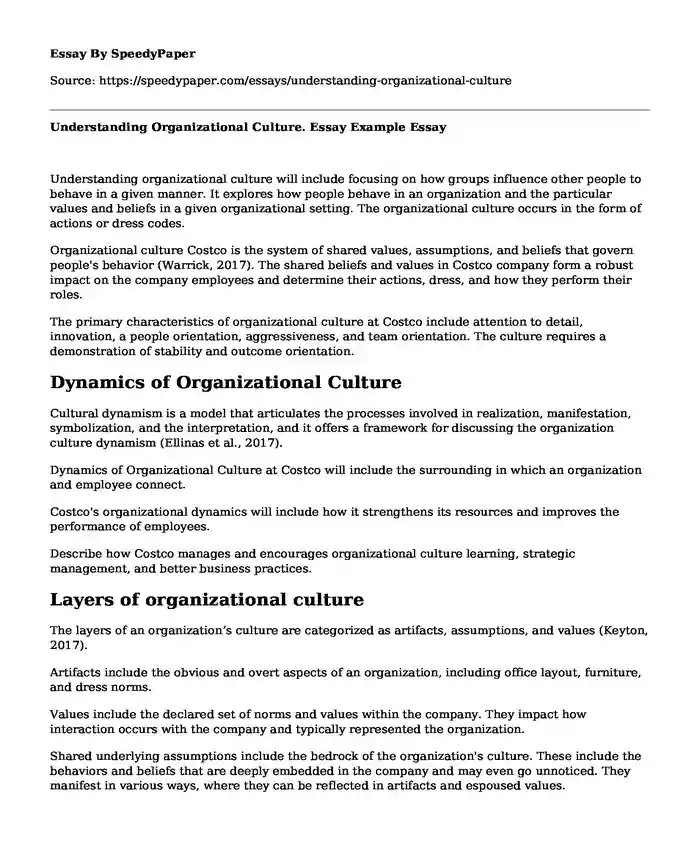
| Type of paper: | Essay |
| Categories: | Human resources Human behavior Organizational culture |
| Pages: | 3 |
| Wordcount: | 633 words |
Understanding organizational culture will include focusing on how groups influence other people to behave in a given manner. It explores how people behave in an organization and the particular values and beliefs in a given organizational setting. The organizational culture occurs in the form of actions or dress codes.
Organizational culture Costco is the system of shared values, assumptions, and beliefs that govern people's behavior (Warrick, 2017). The shared beliefs and values in Costco company form a robust impact on the company employees and determine their actions, dress, and how they perform their roles.
The primary characteristics of organizational culture at Costco include attention to detail, innovation, a people orientation, aggressiveness, and team orientation. The culture requires a demonstration of stability and outcome orientation.
Dynamics of Organizational Culture
Cultural dynamism is a model that articulates the processes involved in realization, manifestation, symbolization, and the interpretation, and it offers a framework for discussing the organization culture dynamism (Ellinas et al., 2017).
Dynamics of Organizational Culture at Costco will include the surrounding in which an organization and employee connect.
Costco's organizational dynamics will include how it strengthens its resources and improves the performance of employees.
Describe how Costco manages and encourages organizational culture learning, strategic management, and better business practices.
Layers of organizational culture
The layers of an organization’s culture are categorized as artifacts, assumptions, and values (Keyton, 2017).
Artifacts include the obvious and overt aspects of an organization, including office layout, furniture, and dress norms.
Values include the declared set of norms and values within the company. They impact how interaction occurs with the company and typically represented the organization.
Shared underlying assumptions include the bedrock of the organization's culture. These include the behaviors and beliefs that are deeply embedded in the company and may even go unnoticed. They manifest in various ways, where they can be reflected in artifacts and espoused values.
Functions of organizational culture
- Culture has a significant role in companies. Some organizations that have created a robust corporate culture have witnessed increased goodwill and gained a good market position (Naranjo-Valencia et al., 2019).
- culture unites Costco’s workers through the provision of a sense of identity with the company
- Organizational culture serves as an informal control mechanism at the company.
- Open communication is facilitated in the organization through the use of organizational culture.
- Costco uses organizational culture when differentiating itself from other companies.
- Further, the culture within an organization, in most cases, produces commitment that supersedes individual interests.
- Moreover, culture is essential in setting organizational rules, norms, and standards. Therefore, it enables workers to function in a company by teaching them behavior requirements.
- Organizational also serves as a shared understanding.
Type of organizational culture
Every company is different, and they possess a special culture that allows the organization of people. An organization usually combines various types of organizational culture.
Hierarchy organizational culture focuses on the structure, control, coordination, efficiency, and stability.
Market organizational culture involves results-oriented, getting the job done, achievement, and valuing compensation of employees.
Process of cultural change
The process of cultural change includes how change needs to be done and how it is communicated within the organization.
Defining the desired values and behaviors within the organization.
Connecting culture and accountability is key to the process of organizational culture.
Organizational culture can be aligned with the brand of a company.
Further, the organization needs to ensure it measures the efforts made.
References
Ellinas, C., Allan, N., & Johansson, A. (2017). Dynamics of organizational culture: Individual beliefs vs. social conformity. PloS one, 12(6). doi.org/10.1371/journal.pone.0180193
Keyton, J. (2017). Culture, Organizational. The International Encyclopedia of Organizational Communication, 1-20. doi.org/10.1002/9781118955567.wbieoc155
Naranjo-Valencia, J. C., Jiménez-Jiménez, D., & Sanz-Valle, R. (2019). Organizational culture effect on innovative orientation. Management Decision, 49(1), 55-72.
Warrick, D. D. (2017). What leaders need to know about organizational culture. Business Horizons, 60(3), 395-404. DOI: 10.1016/j.bushor.2017.01.011
Cite this page
Understanding Organizational Culture. Essay Example. (2023, Aug 24). Retrieved from https://speedypaper.com/essays/understanding-organizational-culture
Request Removal
If you are the original author of this essay and no longer wish to have it published on the SpeedyPaper website, please click below to request its removal:
- Free Essay on the Roles of Equal Employment Opportunity Commission
- Essay Example on The First Emperor of the Qin Dynasty Book
- Free Essay. Violence Against Women Worldwide
- DSM and Porn - Free Essay Sample
- Paper Example. Pinning Ceremony
- Free Essay Sample on Career Expectations
- Free Essay: A Surprise with my Emotions
Popular categories




